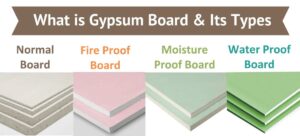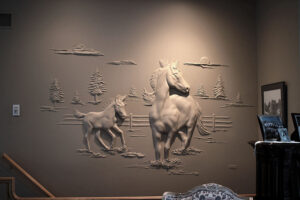Drywall, also known as gypsum board or plasterboard, has revolutionized the construction industry since its introduction in the early 20th century. Its versatility, ease of installation, and cost-effectiveness have made it an indispensable material for both residential and commercial projects. At JMaterial, we pride ourselves on providing high-quality drywall solutions to meet the diverse needs of our clients. In this comprehensive guide, we’ll delve into the various uses of drywall, highlighting its importance and applications in modern construction.
What is Drywall?
Drywall consists of a gypsum plaster core encased between two layers of paper. This configuration creates a sturdy yet flexible material that can be used to construct walls and ceilings. Drywall comes in various thicknesses, sizes, and types, each designed to meet specific requirements. From standard drywall for general use to specialized versions for fire resistance, moisture control, and soundproofing, JMaterial offers a broad range of products to ensure your construction projects are built to last.

The Versatility of Drywall
1. Interior Walls
One of the primary uses of gypsum board is in the construction of interior walls. Its smooth finish provides an ideal surface for painting or wallpapering, allowing for endless design possibilities. Drywall is preferred over traditional plaster due to its ease of installation, repair, and modification.
Residential Spaces
In homes, it is used to create partition walls, dividing spaces into functional rooms. Its lightweight nature makes it easy to handle, and its versatility allows for custom designs and layouts. Whether you’re building a new home or renovating an existing one, gypsum board provides the flexibility needed to create the perfect living environment.
Commercial Buildings
In commercial settings, drywall is used to construct office partitions, conference rooms, and other essential spaces. Its ability to be quickly installed and finished means that businesses can achieve a professional look with minimal downtime. Additionally, specialized types of drywall, such as soundproof or fire-resistant variants, can be used to meet specific building codes and requirements.
2. Ceilings
gypsum board is also a popular choice for ceilings, offering a uniform and finished appearance. It can be easily attached to ceiling joists and painted to match the interior decor. Ceiling drywall can be further enhanced with various textures and finishes to create a unique aesthetic.
Acoustic Solutions
In environments where noise reduction is crucial, such as offices, classrooms, or residential buildings, acoustic drywall is an excellent solution. This type of drywall is designed to absorb sound, reducing noise transmission between floors and rooms. At JMaterial, we offer a range of acoustic drywall products to help you create quiet and comfortable spaces.
Aesthetic Enhancements
gypsum ceilings can be customized with decorative elements such as coffered ceilings, tray ceilings, and recessed lighting. These enhancements add architectural interest and elevate the overall design of a room.
3. Fire-Resistant Barriers
Fire-rated gypsum board, also known as Type X or fire-resistant drywall, is engineered to withstand high temperatures and slow the spread of fire. This type of drywall contains additives like fiberglass that enhance its fire-resistance properties.
Residential Applications
In residential construction, fire-rated drywall is often used in areas requiring enhanced fire protection, such as between garages and living spaces, utility rooms, and around fireplaces. By using fire-resistant drywall, homeowners can significantly increase the safety of their properties, providing peace of mind and potentially saving lives in the event of a fire.
Commercial and Industrial Uses
For commercial and industrial buildings, fire-rated plaster board is crucial in meeting building codes and safety regulations. It is commonly used in stairwells, corridors, and other areas where fire barriers are mandated.
4. Moisture and Mold-Resistant Walls
In areas prone to moisture, such as bathrooms, kitchens, and basements, moisture-resistant drywall is essential. Also known as green board or blue board, this type of drywall is designed to resist water absorption and prevent mold growth, ensuring the longevity and integrity of the walls.
Benefits of Moisture-Resistant plaster board
Moisture-resistant drywall is treated with water-repellent additives, making it less susceptible to water damage. This is particularly important in humid environments where traditional drywall might deteriorate over time. By using moisture-resistant drywall, you can protect your investment and maintain a healthy indoor environment.
Application Tips
When installing moisture-resistant gypsum board, it’s crucial to ensure proper ventilation and waterproofing measures. Using mold-resistant joint compounds and sealing any gaps or seams can further enhance the effectiveness of your moisture-resistant walls.
5. Soundproofing
Soundproof gypsum board is specifically designed to minimize sound transmission between rooms, creating a quieter and more comfortable environment. This type of drywall is denser and thicker than standard drywall, incorporating materials that absorb sound waves.
Residential Uses
In residential settings, soundproof plaster board is ideal for home theaters, music rooms, and bedrooms. It allows homeowners to enjoy high-quality sound experiences without disturbing other household members. Additionally, soundproof drywall can enhance privacy in multi-family residences, reducing noise between adjoining units.
Commercial Applications
In commercial buildings, soundproof gypsum board is used in offices, conference rooms, and healthcare facilities where noise reduction is critical. By incorporating soundproofing materials, businesses can create more productive and serene work environments.
6. Decorative Finishes
Drywall is not just functional; it can also be used to create beautiful decorative finishes. Techniques such as textured drywall, drywall art, and the installation of drywall panels can add unique visual appeal to any space.
Textured Drywall
Textured drywall adds depth and interest to walls and ceilings. Popular textures include knockdown, orange peel, and skip trowel. These textures can hide imperfections and add a custom touch to your interior design.
Drywall Art
For those looking to make a bold statement, drywall art offers endless possibilities. From intricate patterns to three-dimensional designs, drywall can be sculpted and shaped to create stunning visual effects.

7. Renovation and Repair
gypsum board is indispensable in renovation and repair work. Whether you’re patching a small hole or replacing entire walls, it is easy to cut, fit, and install. Its versatility makes it ideal for seamlessly integrating repairs into existing structures.
Patching and Repair
Minor damages like holes, cracks, and dents can be quickly repaired with drywall patches and joint compound. For larger repairs, entire sections of drywall can be easily replaced.
Renovation Projects
In renovation projects, gypsum board allows for easy updates and modifications. Whether you’re adding new walls, expanding rooms, or creating custom features, drywall provides the flexibility needed to achieve your renovation goals.
For more information on our gypsum products and to get expert advice on your next construction project, contact our Sales Team today. Our team is here to help you achieve the best results with the right materials.

